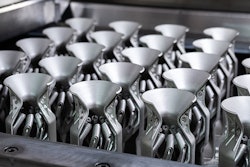
 Jake Rheude
Jake Rheude The gap between B2B and B2C buyers is narrowing, especially online. If you’re still trying to silo your efforts and aren’t looking for sales practices from the consumer market, you could be missing out.
Today’s customers are researching more, exploring digital avenues, and looking for a personal purchase process that is as simple as their favorite app. To make the most of your existing customers and even land a few new ones, here are five considerations to deliver a better experience no matter where you fall in the B2B and manufacturing landscape.
No. 1 - Get Your Foot in the Door
B2B sales funnels and customer journeys are long and winding roads. They’ve got multiple steps and exchanges long before any money changes hands because the purchase process is generally much less spur-of-the-moment. That’s starting to turn with e-commerce and its dramatic rise in the U.S.
The American consumer audience has shifted from a few people willing to buy things immediately via infomercials to the majority who can fire up a PC or phone, find a product, and make a purchase that’ll get to them in two days.
Convenience has won over the masses. And, those are the same procurement officers who are buying your B2B goods.
So, it’s time to jump into the beautiful world of impulse shopping and immediate sales to fill needs. What this means for your business is that you’ll want to promote offers that have a low cost or barrier to entry. Something simple and easy that’s ready to go.
For manufacturers, this can often be small tools, parts, or components. You can also provide or sell eBooks and other materials about how to utilize your products. One candle manufacturer was able to get their foot in the door by selling wicks at cost and then turned those buyers into companies who wanted oils, waxes, and more.
No. 2 - Focus on Benefits
The B2B world often highlights the features of a service or product. We look at what it can do for the client, typically how it makes work easier and more efficient. On the other hand, B2C marketers often focus on the benefits of a product.
B2C doesn’t sell a great mop based on it’s the bristles. It sells based on how quickly and effortlessly it cleans so that you can get back to something more fun. B2C marketing aims at the emotional side of a product and the benefits. Keeping the message simple and direct makes the pitch more compelling.
A robust B2B campaign needs to bridge features and benefits. Highlight the technical elements and features of your products in light of the benefits they provide. Talk about the reasons why they’re a smart financial investment with the gains they could make in things like efficiency, workforce, or inventory optimization, and reduced stress.
No. 3 - Reach out to the Individual
The B2B buying process often involves multiple stakeholders, from the person who’ll use your product to acquisition teams and management holding the purse strings. Committees can be a big buyer for any B2B sale. The B2C market focuses on the individual decision-maker who is often doing all of the research and final buy on their own.
The critical lesson from B2C here is that they provide the individual with everything that they need to make an educated purchase.
Your mission is to arm your core target with everything they’ll need to manage the decision process. Give them the talking points that can use for each step in their purchase process. Treat the reader and ad target like an individual, and you’ll be primed for a more significant connection even if it reaches different stakeholders.
No. 4 - List Your Prices
Buying a B2C product is straightforward. You can see the price, taxes, shipping, and just about everything else with a few clicks. In B2B, not so much. Many companies hide their pricing behind accounts and paywalls and phone calls.
In the manufacturing space, there’s rarely a need for secretive pricing beyond custom efforts. Your buyers are getting used to having detailed information available to them at every purchase decision in their daily lives, so the same expectation is bleeding over into work lives as well.
While B2B pricing is often a little more complicated, it still needs a baseline and shouldn’t require significant heavy lifting from the customer to get started. When final elements have a negotiation aspect, then you’ll want to give a baseline at least to help customers start their planning.
No. 5 - Go Mobile-Friendly
Younger consumers are driving e-commerce, and they’re starting to move into the B2B purchasing space too. They’re bringing many of the same expectations to your website, catalogs, and more. Even as far back as 2015, 42 percent of B2B buyers were using mobile devices somewhere during the purchase process.
Your marketing and website need to focus on the mobile customer and draw them in—and mobile-only customers even tend to close the deal much faster.
Unfortunately, many leading websites from manufacturers aren’t mobile-friendly. They have not adopted responsive design to adapt to smaller screens. If you need a little help, consider firing up some B2B e-commerce tech that is mobile-optimized and reviews what they offer for customers on their phones as well as PCs.
Look into how their tech support and chat works on mobile, the different landing page techniques used, and how they support the purchase process. You want to be able to reach someone on their phone on the way to the office and connect this to the experience they have when they get into the office and browse on their main PC too.
B2B platforms are a great place to review all of your options and capabilities. E-commerce systems can help you get a feel for the way customers expect information on delivery, replenishment, customer service, and much more. A physical product will always have robust logistics backing and fulfillment, but your customers are initially going to expect a more Amazon-like approach.
Today’s B2B commerce is shifting more in line with B2C efforts. Find your favorite brands and review their hooks, marketing, targeting, and site information to see what you can do to start attracting your best customers.
Jake Rheude is the Director of Marketing for Red Stag Fulfillment.























